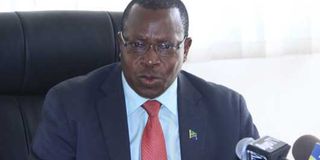Tanzania’s share of global GDP improves

Finance and Planning minister Philip Mpango speaks at a past event. PHOTO|FILE
What you need to know:
According to the ‘World Economic Outlook-2016’ of the International Monetary Fund (IMF), Tanzania’s share of the global economy remained unchanged at 0.06 per cent for three decades from 1980 to 2010, when it gained to 0.08 per cent.
Dar es Salaam. Tanzania’s share of the Gross Domestic Product (GDP) vis-à-vis the total world GDP will reach 0.1 per cent by the end of this year, rising from the 0.08 per cent that was recorded in 2010.
According to the ‘World Economic Outlook-2016’ of the International Monetary Fund (IMF), Tanzania’s share of the global economy remained unchanged at 0.06 per cent for three decades from 1980 to 2010, when it gained to 0.08 per cent.
The global economy was estimated at $75.5 trillion in 2016, according to World Bank.
Tanzania’s GDP averaged $18.26 billion from 1988 until 2016 – reaching an all-time high of $48.20 billion in 2014, after a record low of $4.26 billion in 1990!
The increased GDP share was a result of expansion of all major key economic indicators, including personal consumption, investments (private and public), government expenditure and exports of goods and services.
Also, the country’s consumption increased from $11 billion in 1980 to $163 billion by 2017, with the rate projected to reach $250 billion by the year-2022.
Currently, Tanzania is the twelfth largest economy in Africa, and the GDP is projected to be $54.36 billion by the end of this quarter – roughly equivalent to the current economies of Belarus and Libya, according to Trading Economics global macro models and analysts expectations.
In the long-term, the Tanzania GDP is projected to trend around $61.23 billion in 2020, according to econometric models. That is equivalent to the current GDPs of Luxemburg, Costa Rica, Panama and Uruguay.
Since 1980 to-date, significant measures have been taken by Tanzania to liberalize the national economy along free market lines, as well as encourage both foreign and domestic private investments.
According to the IMF, Tanzania’s GDP – which is estimated to reach Sh110 trillion (about $50.7 billion) this year – has continued to expand for years, thereby possibly becoming East Africa economic giant by 2025.
However, this trend can only be reached through a sustained annual economic growth of not less than seven per cent over the next five-to-ten years – and if the Kenyan economy will grow at a slower pace, according to analysts.
Tanzania is now ranked the 82nd largest economy in the world, out of 211 countries surveyed, according to the World Bank Report-2016.
However, the IMF ranked Tanzania at 84th place in 2016, while the United Nations ranked it as the 87th largest economy in the world in 2015!
The smallest economy in the world is Tuvalu with $38 million.
As of the year-2015 estimates, Kenya had a GDP of $69.977 billion making it the 72nd largest economy in the world. Its per capita GDP was estimated at $1,587 that year.
The Bank of Tanzania’s 2015 Financial Stability Report indicated that drivers of GDP growth include ‘continuous investment in infrastructure, expansion in private and public sector construction activities, and improvement in the external sector.’
A new report by Global Finance has it that the country’s GDP per capita is also expected to jump to $1,017 by the end of this year – up from $897.19 last year.
Thus, it is a long way to go for the country to reach an average annual income of $4500 (about Sh10.3 million), so as to become the middle income country that the National Development Vision-2025 envisages.
The World Bank’s World Economic Outlook database for October 2017 shows that Tanzania’s GDP is expected to hit the $51.6 billion mark this year, up from $47.7 billion last year. That is still lower than Kenya’s projected GDP of $55 billion.
With an improved income and share of GDP to the global economy, Tanzania still has 12 million people who currently live on less than a dollar a day. This is roughly 25 per cent of the total population.
The United States is the world’s leading economy, with a $19 trillion GDP – which is 24.9 per cent of the global GDP. China is next, with a GDP of $11 trillion: about 14.7 per cent of the global economy.
Japan is in third place, with $4.8 trillion.




